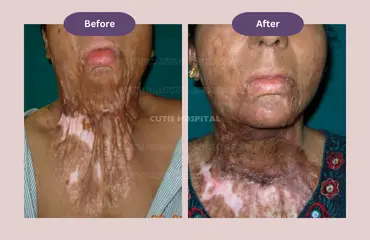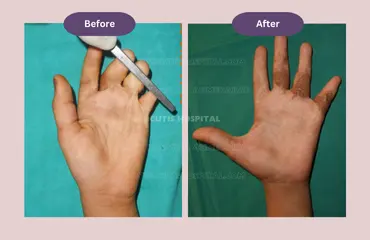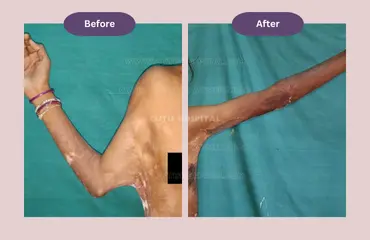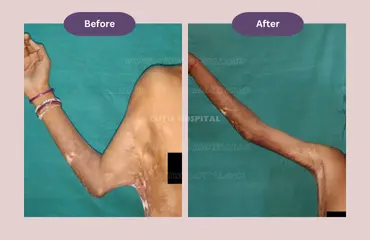Burns can scar and disfigure large areas on the body, and impact the patient’s life due to psychological and physical problems like depression, anxiety, social avoidance, and rigid mobility of body. Hypertrophic scars occur following burns, trauma, and inflammation, and cause contractures in tissues that lead to deformities.
To heal the wound, improve its appearance and mobility of body, large raw area must be covered, and full thickness skin graft is the common post burn raw area treatment used. Depending on the wound size, this surgical procedure can be done once or multiple times.
Post burn raw area treatment includes two main surgeries:
Acute and reconstructive surgery
Z-PLASTY:
This surgical post burn raw area treatment involves excision of the whole scar tissue and adjoining areas to mobilize the limb functions. It’s primarily used for facial burns to help stretch the surrounding tissue and improve the appearance of the scar.
Contracture Release and Grafting:
It involves excising the whole scar tissue and covering it with a split. It’s used for non-joint surfaces and where sufficient tissue is not available for closing the scar wound and for improving the limb functionality.
Scar Excision and Local Flap Cover:
It involves excising the whole scar tissue and locally available soft tissue and skin to cover the defect. The flaps are strategically designed to prevent further scarring.
Free Flaps:
To manage large defects due to post-burn scars and contractures, free tissue transfer from the donor site is a wise surgical treatment option.
Tissue Expansion:
Implanting tissues to cover the scar wound, this technique is deployed. The skin is harvested in the laboratory from the patient's skin cells for the procedure to be completed.
Post burn raw area treatment
The goal of post burn raw area treatment is to remove the scar tissues, clean and close the wound to prevent infection and improve mobility of limbs. Surgical excision and skin grafting is done for deep burns while superficial burns require only cleaning and debridement.
If adequate wound care is not taken post burn raw area treatment, then complications can occur such as infection and sepsis, skin graft failure, and split-thickness donor sites converting into full-thickness wounds, which leads to immobility of limbs.
After a burn wound is healed, it leaves thickened marks called scars. Usually, second- and third-degree burns cause scarring. To prevent or reduce scars wearing pressure garments helps.
Contractures occur when the scar thickens and tightens, preventing movement. By wearing a splint, and practicing range of motion exercise, mobility to limbs can be restored.
Our surgeons, critical care specialists, physiotherapists, and support personnel work in synergy to deliver quality care. Our well-trained staff assists patients and their families to hand emotional trauma, and enable them to live a normal life post the surgery.






Minor burns that affect the outer skin layer heal within 14 days and leave no or minimal scars. Full-thickness or second-degree burns take three weeks to heal. Deep or third-degree burns take a couple of years to heal completely.
Reconstructive burn surgery aims to improve the appearance of the scar wound and enhance the functionality of the limbs. Both surgical and non-surgical treatments are used for removing the scar tissue. Results from the post-burn raw area treatment are visible after several months.
Usually, surgical methods like skin grafts, skin rearrangement (Z-plasty), and skin donor flaps are used to treat the scare tissues. Depending on the severity of the scar wound and patient’s objectives the surgeon will asses and suggest any of these treatment methods.
Your medical team will suggest to wear splint, wear pressure garments, do stretching exercises, and massage the scar. Protect your healing skin from the sun by applying sunscreen with SPF 30 and wearing protective clothing like long sleeves shirt or a hat.
Post-burn scars remain on the skin as it depends upon the burn injury depth. Scars can only be minimised by plastic surgery and physical therapy but cannot be completely eliminated.
Cutis Hospital is conveniently located in Ghatlodia, Ahmedabad, making it easily accessible via multiple modes of transportation. Below are the various ways you can reach our facility:
Sardar Vallabhbhai Patel International Airport: Located approximately 12.7 km from Cutis Hospital, offering convenient access for patients traveling from outside the city.
Chandlodiya Railway Station: Approximately 2.4 km from Cutis Hospital.
Ahmedabad Railway Station: Around 11 km from our center.
GSRTC:
Ahmedabad Central Bus Station (GSRTC): About 10.3 km from the hospital.
AMTS:
Bhuyangdev Cross Road Bus Stop: Just 500 meters from Cutis Hospital.
BRTS:
Bhuyangdev BRTS Bus Stop: Only 170 meters from our center.
We provide effective surgical and non-surgical treatments for all parts of the body. At Cutis Hospital, our cosmetic and plastic surgery team is committed to giving patients safe and high-quality care.